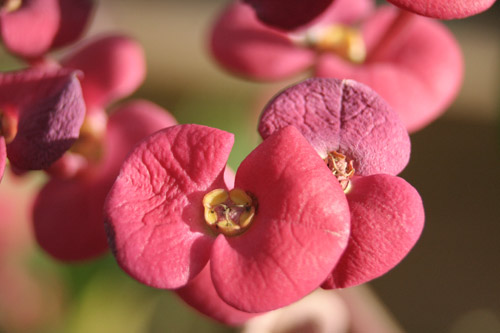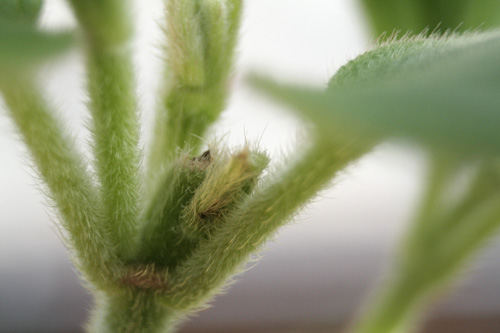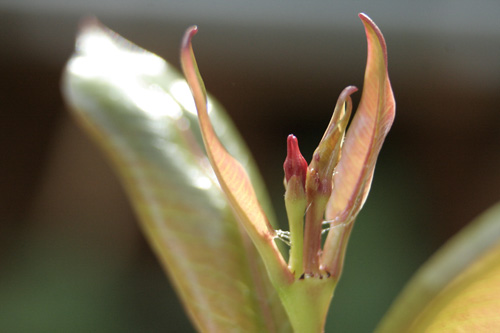on macro photography

As I’ve mentioned previously, this new year I’ve been learning how to do macro photography with our DSLR camera, first with a zoom-macro lens, then with extension tubes. So far I’ve been happiest with a single 36 mm extension tube joined with the regular lens (18-55mm). There are two more rings or tubes that I will be testing out some more in different combinations.
After a few practice sessions here are the most important lessons I’ve learned and am noting here for my own records and for any readers who may be interested:
1. One needs very good light conditions. The length of the macro ‘tube’ reduces the amount of light reaching the sensor (‘film’). Dark rainy days are not conducive to this kind of photography. Yesterday’s sunshine let me do a lot of work in the solarium with easy and still subjects in my flowers and plants, and a few outdoors in the garden as well.
2. One must use a tripod. Any shake is amplified in macro resulting in very blurry shots!
3. Even better, use the timer setting on the camera. Even manually pressing the shutter while the camera is on the tripod can move the camera a little. We attempted a shutter cable from our ancient film SLR camera but there is no input on our DSLR. Great invention, the timer!

4. Largest f-stop (smallest lens opening) is generally best. See #1.
5. Eyeglasses get in the way of focusing! Setting the diopter adjustment in the camera to my own vision in the right eye (similar to ones on binoculars) allowed me to focus more clearly, though it is annoying to keep taking glasses on and off (wear something with generous pockets!).
6. One need lots of time to set up the tripod and camera and focus! Practice will improve speed I’m sure.
7. All this heavy equipment – a big camera, different lenses and a tripod – means that I’m not likely to take these along on quick casual walks. The little point-and-shoot is pretty good for that. When I really must take the superior equipment, I will have to use one of those upright shopping carts on wheels, even if it makes me look like a bag lady 🙂
All this is old-hat to expert photographers so please don’t laugh at my amateurish struggles. I’m learning (thanks to husband’s patient help) and getting ever more excited by the results. Whoo-hoo!
No adjustments to these photos have been made in iPhoto or PhotoShop other than resizing and compressing for the web. I wish you could see them full-screen size! More photos to come….

January 17, 2010 in Being an Artist, Nature, Photography, Photoworks by Marja-Leena
WoW, beautiful images and great information. Thankyou. I am guilty of not readng my little camera manual and utilising all the functions. You have inspired me to get reading.
Thank you for information and bright, colourful photos!
Kiitos hyvistä neuvoista. Juuri tällaisia olen kaivannut.
Ostoskärryn kanssa kulkeminen ei olisi ongelma, sillä täällä Helsingissä niitä käytetään päivittäin ostoksilla käydessä. Mutta kameran ja lisälaitteiden paino kuvaamistilanteessa nujertaisi minut.
Olen saanut aika tarkkoja kuvia pienellä kameralla, kun olen laittanut sen tasaiselle alustalle tai tukemaan vaikkapa ikkunan tai ovenreunaan ja käyttänyt aikalaukaisua. Usein tuen kameraa mieheni olkapäähän, ja hän sanookin olevansa sivutoiminen kameranjalusta.
Odotan hartaana uusia tehokkaampia pikkukameroita.
hhb, glad you found this of use. I don’t read the manuals much either, frankly. I still have trouble accessing some of the stuff, such a technical nitwit that I am!
Leena, kiitos sinulle!
Anna, mukava että tästä oli apua. En minäkään jaksa kantaa paljoa jotta kärry on hyvä vaikka hieman outo ja hankala metsä poluilla ja rannoilla. Meidänkin pieni kamera on aika hyvä ja siinä on ns. anti-shake. Se vain ei niin läheltä ota kuvia kun erikois macro linssi ja kuvan laatu on vähän huonompi. Uudet kamerat aina vain parempia ovat ja hinnat putoa, niinkuin tietokoneittenkin.
So beautiful, and thanks for sharing what you’ve learned! I gave up macro photography with my Nikkormat when we switched to digital and haven’t explored it with J.’s cameras, but I really miss being able to play with depth of field, as well as getting so close to the subjects. You inspire me to try…but like you, the heavy equipment gets in my way!
Beautiful photos!
Oh, too complicated! Although I love the macro closeups because of their incredible clarity to see things like a bug would, still, I am content to take photos a point and shoot way….I’ll leave the experts and you to this specialized work!
Beth, thanks! I used to sometimes play around with depth and field with the old film SLR but got away from it with the digital cameras, like you. It’s a learning process all over again but I love the results!
Leslee, thanks!
Taina, yes, I think so too but it gets easier with practice. I’ve long admired macro photos by many photobloggers and kept wishing for a macro lens. Now that we have them, I’m determined to learn how to use them well. Photo processes are very much a part of my artmaking too, so this opens up new possibilities for me. The point and shoot camera will still be in use for times when I don’t want to carry heavy equipment or to fuss.
I know I’m never going down this particular creative but these pictures really are very beautiful. Thank you for posting them 🙂
Susan, thanks! Each to his/her own, as they say. I guess I’ve been bit by the photo bug 😉
And wow, four comments in a row from you, what a blessing!
Between my retirement and Mrs BB’s I occupied myself with PR (£250 a day) which included photography as well as text. This was pre-digital so there was no checking the print on the back screen. On top of this most of the shots were indoors in gloomy manufacturing plants. The tripod was essential as was the cable trigger since exposure times were sometimes as long as half an second. And yet again, there was a limit to the size of aperture since the depth of field can shrink alarmingly when you get really wide. However, having travelled, say, 100 miles to take the shot and being aware that you were charging someone else for what you were doing were excellent disciplines for getting it right. Quite simple really: film’s cheap and I simply shot a range of speed/ap combinations. Oh, and I had a decent camera, a Pentax M50, having been let down by a Fuji cheapo about 50 miles west of Toronto. Happy days (I lie! I lie!)
BB, what a varied career you’ve had. One really does learn ‘on the job’ too. Bracketing as you describe used to be pretty common with film cameras, but how slow it was, waiting for the film to be developed then checked. Reminds me of the process of taking slides of my art work! A few galleries still insist on that archaic practice today.
Our first SLR camera was also a Pentax, the Spotmatic II bought in 1970 in Calgary and it’s great! So disappointing that we could not use its superior lens on our Canon DSLR. Should have bought a Nikon. Happy days indeed!
Thank you for the notes! And really interesting that you are working with tubes too. After reading about them in UE, I thought I’d try my Czech at finding a set, but if they take a lot of light, maybe I should wait until spring ;-).
Julia, I found that using just the one tube worked the best for me in the lighting I had so that’s not quite as limiting as all three together were. I’m sure you get more bright days in Prague than we do!
Super shots, Marja-Leena! I have a fondness for macro photography … the hint about having big pockets is so true! I really must get out and play more with my Olympus Stylus.
I’m looking forward to more close-ups from Canada!!
R, thanks! Does your Olympus have a macro setting? So many of the point and shoot digicameras have that as one option, as does our Lumix. I’ve just been wanting more depth of field control.
You convinced me. I think I may have caught camera apparatus fever, uh oh ;-).
Hello Marja-Leena! Good to get back in touch with you! Thanks for the comment on my blog the other day. Yes, I’ve been away TOO long!
One thing you may find is that you can get much closer and worry less about light and have a much better depth of field if you use a compact digital camera. Because of the distance between the lens and the sensor compact digitals can get to about a centimeter away from the subject. Of course, if you are photographing moving creatures getting that close is a mite hard to do! I hope to one day find an endoscope lens so that I can attach it to my compact digital camera and get very close macros with wonderful depth of field (http://www.lennartnilssonaward.se/winner15/satoshi_kuribayashi.html). I’m utterly fascinated with the insect world and would love to take photos that give you the sense of being right there in their world.
Julia, it’s an expensive hobby, for sure! If you do go for it, I look forward to reading about your explorations.
Hi Miguel, wonderful to hear from you! Thanks for that link – amazing images and lens! Good point about the compact digital camera, IF you have one with a good macro setting. I have often used that setting on ours but it is not as good as I’d like it to be. Fred bought the zoom-macro lens first and that should be great for taking bugs and birds from farther away, in good light, though we haven’t had a chance to catch any creatures yet. The closest one can stand to objects is a metre or so, which feels so odd to me, and it’s a very long lens. The extension tube on the other hand lets me get very close up. There are many pros and cons with all of these and I think I’m just trying to find my own comfort zones with the different choices.
The Olympus has 2 kinds of Macro settings … one “regular” and one digital. Do you recall the photo of the bumble bee I posted several months ago? That was taken using the “regular” macro setting. The cricket was taken using the digital macro setting.
rouchswalwe, that sounds confusing, as if one setting is not digital. Is one ‘closer’ than the other?
It’s amazing how many of these features my little Nikon has. But of course the lens is not large. It’s not very refined, but good enough for me.
I’m resisting the impulse to find a better camera, because I am sure I would become obsessed with photography!
I love your work, Marja-Leena!
Hattie, glad you like my work! Your Nikon must be a good camera. As you can see my resistance has broken down and I am now obsessed.